“We consider something like this… an operational project. It’s not something that we have a vote on.”
– Scott Cohen, PBOT, at a neighborhood meeting last night.
At long last, the Portland Bureau of Transportation will take steps to redesign a stretch of Northeast Ainsworth street that will make it less stressful for bicycle riders. At a meeting of the Woodlawn Neighborhood Association Thursday night, the City announced plans to add 11 speed bumps (technically called “speed cushions” by PBOT) to the street between Martin Luther King Jr. Blvd and 15th.
The new speed bumps will have a channel for emergency vehicles since Ainsworth is an emergency response route. The proposal was met with pushback from some people at last night’s meeting, but PBOT project manager Scott Cohen was well-prepared and deftly answered every concern raised.
Ainsworth east of MLK has a long history of annoyance for bicycle riders. Despite it being a designated bike route with a (relatively new) speed limit of 20 mph, this local street is used as a cut-through by many drivers — and most of them drive way too fast. The street itself is split by a very wide, park-like median and the presence of parked cars leaves very little space for traveling.
This difference in vehicle speeds and expectations between drivers and bike riders has created a lot of tension over the years.
In 2008 a pair of cyclists was riding on Ainsworth when they were passed closely by a Portland Police officer in a patrol car. They gestured to the officer out of fear and were then given nonsense traffic citations that were later dismissed by the courts. The PPB ultimately promised to train the officer about the legal rights of bicyclists.
In 2010 we shared the community’s desire to reimagine Ainsworth as a more human-friendly street. Then in 2011, we covered a neighbor’s attempt to encourage bike riders to stay off the street. And in 2018, someone was so mad about the new 20 mph speed limit they tried — and failed — to organize a revolt.
So here we are in 2023 and PBOT has this section of Ainsworth on their list of traffic calming projects to be completed this year. “We’ve heard that people drive too fast on NE Ainsworth and too many people are using the street as a cut-through instead of using more appropriate streets like Killingsworth or Rosa Parks,” PBOT’s Cohen told a few dozen people at the hybrid online/in-person meeting. He added that the goal was to make it a “more neighborhood-friendly street.”
Cohen is in charge of the project and spent most of Thursday night’s meeting addressing concerns from residents.
The list of reasons why some neighbors don’t want the bumps include: their opinion that speed bumps are ineffective, that the bumps slow emergency response times, are expensive to install and maintain, make driving less safe, and that bicycle riders don’t like them.
Cohen went through a presentation showing the impacts of speeding on death and serious injury. Then he laid out how PBOT traffic analysis shows there’s way too much speeding on Ainsworth and that speed bumps are their best tool to reduce that behavior.
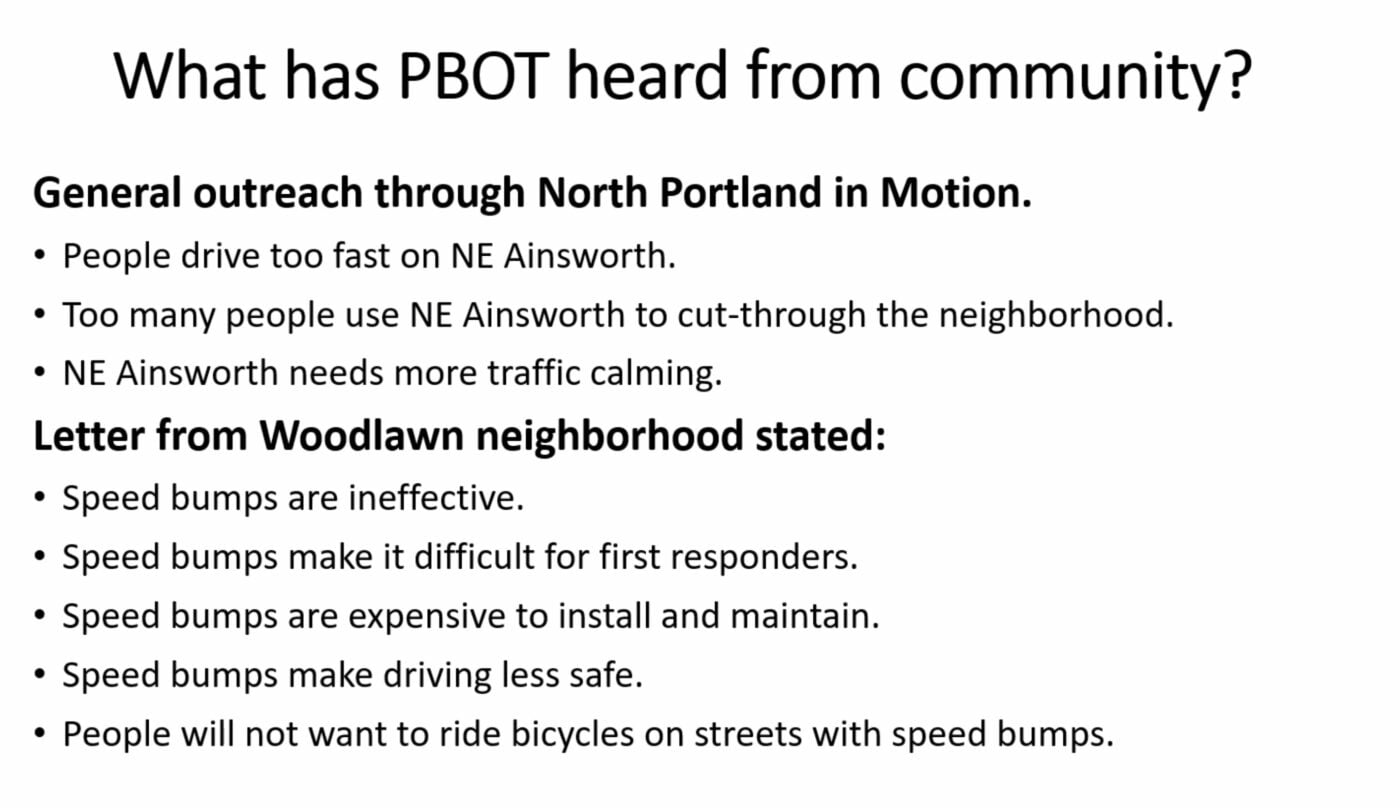
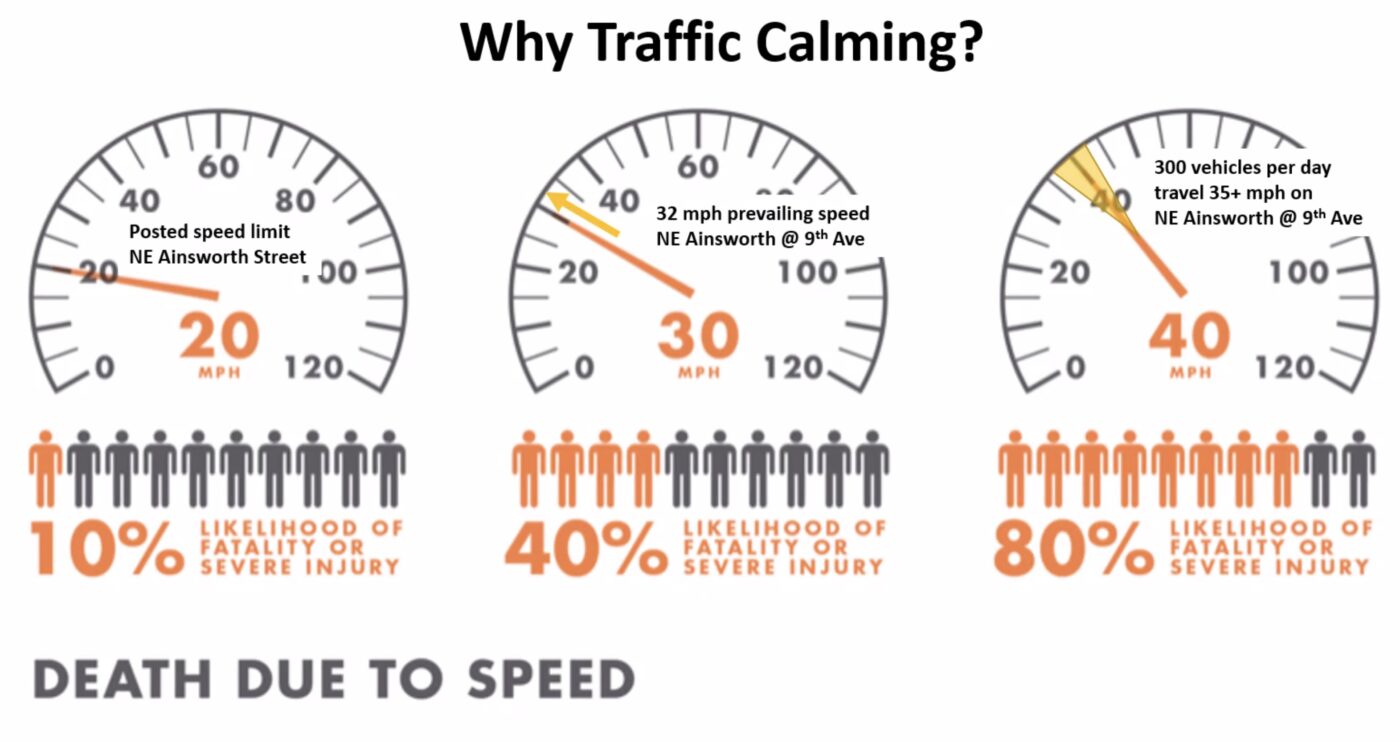
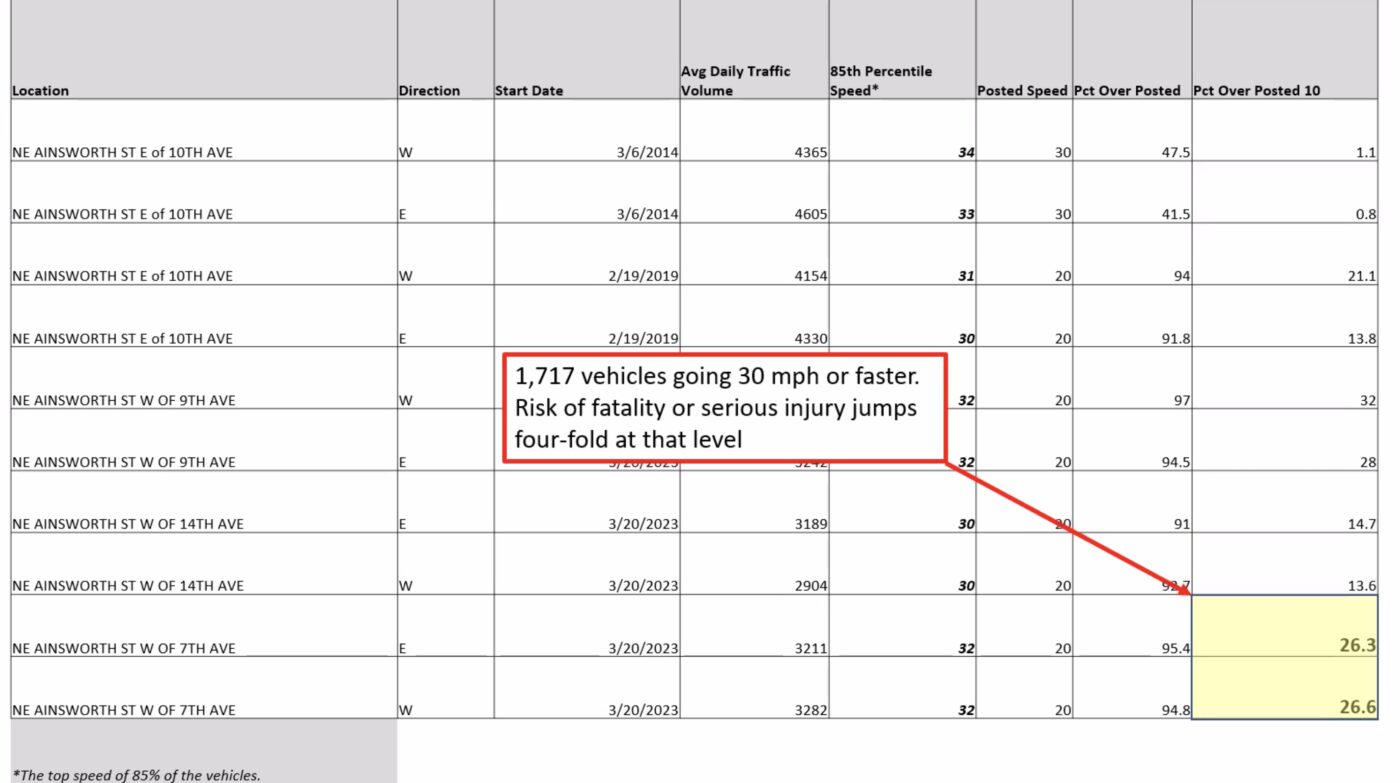
According to PBOT speed measurements taken back in March, the prevailing speed at NE Ainsworth and 9th is 32 mph — that means the risk of death or serious injury is four times higher than if people were going 20 mph. And 300 vehicles per day travel 35 mph or more at that location (at 40 mph or more, there’s an eight-fold likelihood of death or injury compared to 20 mph).
At Ainsworth and 7th, PBOT data shows that over 26% of drivers — or 1,717 people per day — drive 30 mph or faster. He then compared that with a nearby section of Ainsworth that already has speed bumps and showed that just 245 vehicles per day are driven 30 mph or faster. He also showed results of traffic studies as other locations around the city where the installation of speed bumps led to a significant reduction in speeding.
But it wasn’t enough to convince one guy who stood up to make his comment.
“I saw your numbers. I saw your graphs. But my real world experience is vastly different from that,” the man said. “I think the only thing speed bumps do is make it untenable, a drastically lower quality of life for those people that live on the street and are subject to the noise of larger vehicles and smaller vehicles that are braking and speeding up to go over at a speed where it causes their equipment to bounce…”
Cohen calmly replied that PBOT can never make 100% of drivers follow the law. “Speed bumps, as I said, are our most effective tool. Yes, there are still some people that are going to go too fast. But instead of it being 1,700 vehicles a day, it’s going to be 200 or so. It is just our best tool.”
“If the data shows relative ineffectiveness? Is there a mechanism in place for removal [of the bumps]?” the man asked.
“We have yet to remove bumps, as far as I know, because they were ineffective. So that would be that would be the first time,” Cohen replied.
Faced with the concern that bicycle riders don’t like the bumps, Cohen pointed out that they are already standard practice on the City’s vast neighborhood greenway network — streets made specifically for bicycling.
Faced with the concern that the bumps would divert drivers to nearby streets, Cohen said that really doesn’t happen. “We very rarely see diversion from speed bumps. Diversion happens usually from diversion [median diverters and such]. Speed bumps just lead to lower speeds and not a change in the number of vehicles that use the street.”
Faced with someone who felt the design of the speed bumps wouldn’t work and that they’d be problematic for first responders, Cohen said, “I’m very confident in our traffic engineer who design this project and who’s got 25-plus years of experience doing traffic calming. And we came up with with this agreement with Portland Fire & Rescue.”
And then, he added this zinger:
“We consider something like this project, one that is reducing speeds, to be an operational project. It’s not something that we have a vote on. The voters voted on this project in 2020 with the Fixing Our Streets program with close to 80% support and it included this program for traffic-calming on neighborhood cut-through routes.”
Now that’s how you frame these type of projects! Cohen’s style of kind confidence should be a template for how PBOT handles neighborhood meetings. We will never achieve our goals if we allow opposition to basic, proven safety measures to draw out and/or derail small projects like this.
PBOT is ready to move forward to construction and the speed bumps should be installed during this construction season (before winter).
Ainsworth is poised for even further evolution with a neighborhood greenway treatment west of MLK that was recommended by PBOT in the North Portland in Motion plan.



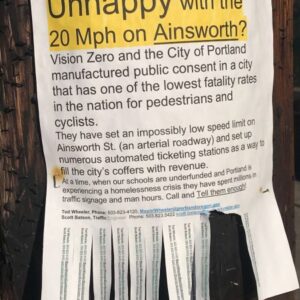

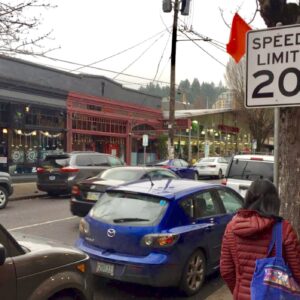
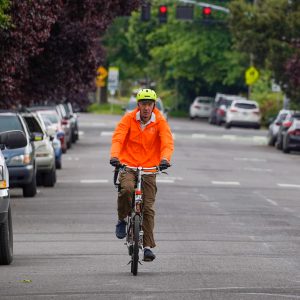
Thanks for reading.
BikePortland has served this community with independent community journalism since 2005. We rely on subscriptions from readers like you to survive. Your financial support is vital in keeping this valuable resource alive and well.
Please subscribe today to strengthen and expand our work.
I love the speed bumps (cushions) for the traffic slowing but I dislike riding up and over them on my bike. I hope they can put in the bike slots! The slots make riding so much smoother (and faster).
Great recap of the meeting, Jonathan. Fingers crossed PBOT can get this project off the ground, as planned, in 2023.
If people are using the street as a cut through, and pbot wants to reduce that, wouldn’t traffic diverters be better to achieve those goals than speed cushions?
I fully support slowing down traffic and speeds on Ainsworth but I don’t think speed cushions are the right tools to get us there (especially with the car convince cuts installed on the speed bumps… er I mean emergency vehicle channels) .
Plus, Rosa Parks is a way better street for emergency vehicles to access the neighborhood by since Ainsworth is so narrow with parked cars there is no way for cars to pull for over to let first responders pass
I wouldn’t think you could divert if it’s an emergency vehicle route.
Rosa Parks east of MLK becomes narrower and not suitable for emergency vehicles to travel easily
This made me laugh out loud. Yeah bro, we know you put them on all of the greenways, and we hate that they are there because they don’t do anything except make biking harder.
***Moderator: rephrased sentence *** Cohen is attached to the worst projects PBOT does and gaslights about how poor the projects are at all of them.
You didn’t ‘rephrase’ anything, you just edited my post to soften my critique. I know you’re a massive booster of PBOT but jeez, lets be honest here.
Maybe you don’t remember what you wrote. No incisive critique, just garden variety name calling.
They also make motor vehicle traffic drive slower, but yeah, other than that they only make biking harder.
I don’t like biking over them either, but I prefer it to avoiding the street because traffic on it sucks. And even leaving cycling out of the picture, I just prefer slower (and maybe less!) traffic on this street for pedestrians and neighbors.
Exactly. I’ll deal with a few bumps if it means I can generally outpace a car and not have to worry about people close passing me at 30+ mph on a neighborhood “greenway”.
Here we go again with the emergency cutouts. Lol. Those only stop the do good types.
I live close and I’d love for speed bumps on Ainsworth (and I ride my bike and I drive on Ainsworth)
I’m exactly the opposite.
You don’t live close, and you would not like speed bumps on Ainsworth (And you don’t drive or bike on ainsworth?)
Wonderful. Cohen did a fantastic job selling this project!
Traffic diverters are needed. They remove the cut-through incentive that attracts the sociopaths who are willing to speed on streets like this one.
I really don’t get the controversy with bikes going over speed bumps. Yeah they’re kind of uncomfortable to ride over but compared to the sorry state of the pavement itself on our greenways it’s pretty miniscule. Just today I was riding the Salmon street greenway to get downtown. It’s crisscrossed with half-hearted patches from water and sewer projects and pockmarked with potholes and sunken pavement.
The real discomfort when biking comes from all the cars. Speed bumps are shown to reduce speed and discourage drivers from rat-running using the greenways. They might be expensive to install but are way cheaper (therefore more can be installed more quickly) than other traffic calming features like bump-outs.
What is Mr. Concerned Citizen’s plan for reducing speeding in his neighborhood? Put up more “please slow down” signs? Put a cop on every corner?
A few years ago I was biking westbound around 10th & Ainsworth and was passed by a car whose passenger shouted “Holman!”. Of course, one minute later I caught up with them at the light at MLK, as usually happens with every fast-driving car on Ainsworth. It was an elderly couple. “What’s the rush, grandma?!”
Holman pavement was the worst, and probably still is. People need to be okay with bikes on Ainsworth, and patient being behind them when there’s parked cars and such. I always thought about some kind of bike lane down the median, or just removing all the parking from Ainsworth.
You should have shouted back that their car should be on Rosa Parks or Killingsworth.
Or on I-84 “It’s just a few blocks that way”
With a center median and on-street parking, I do not understand how speed bumps with channels for emergency vehicles will work because there are no options for where to locate the channels. Firetrucks and ambulances have pretty similar track widths to cars, especially considering the emergency vehicles have dual wheels and require 18″ cutouts. On other Portland streets with cutouts for emergency vehicles, the design requires the emergency vehicle to straddle the center line to use the cutouts, meaning cars and trucks can only use one cutout if they stay in their lane. On Ainsworth, the planted median prevents the emergency vehicle from straddling the center line, so the cutouts will be set up so that cars and SUVS will basically HAVE to use the channels, leaving the speed bumps exclusively for motorcycles or bicycles who want to ride in the center of the street. Is there a plan/section of this- I am very skeptical.
Exactly, these will be car cutouts. There is no way given the street width, parking, and median to not have the cutouts align exactly so cars can completely disregard the “speed cushions”
Except it’s simply not true that emergency vehicles have similar track widths to regular cars and trucks. They are wider. It’s not possible for someone driving a normal car to use both channels. At most they can use only one, and thus the speed bumps are still effective.
Shhh . . . better not tell the crew that installed speed bumps in my neighborhood that they did it all wrong. I see cars, SUVs, trucks, and delivery vehicles routinely drive through the cut outs and fitting in both channels just fine.
Maybe PBOT will have to go back out and do the speed bumps properly, just like they failed to do the ADA sidewalks properly the 1st and 2nd and sometimes 3rd time around.
Unfortunately, most vehicles are going to be the size of fire trucks in a few years:
https://www.statista.com/statistics/199983/us-vehicle-sales-since-1951/
Emergency vehicle tracks are wider, but to accommodate the dual wheels the cutouts are close enough enough together that it works for the tracks of midsize cars on up to SUVs and pickups.
Well, to quote tfa,
Maybe if you don’t know the specifics of what you’re talking about, don’t assume they just made bicycle bumps that have no effect on cars. If you do know the specifics, share them instead of just making wild assertions.
https://nacto.org/docs/usdg/offset_speed_tables_for_reduced_emergency_response_delay_batson.pdf
A Typical Fire Engine has a track width of 77″. If each gap is 18″ wide, the gap would accommodate a track width of 41″ to 77″ .
The attached diagram shows how the design places a cutout in the center of the road so an emergency vehicle can take up the whole road to use the cutouts, but a vehicle staying within their lane would only be able to use one cutout. On the segments of Ainsworth with a center median, the cutouts will have be in the lane, so I am wondering how they will modify the design. They could narrow the gap but the inner rear wheel would still hit the bump.
The center median seems like a red herring. Perhaps in a road without a median, more drivers are reluctant to attempt to use the gaps because they’d be crossing the middle line.
But even on Ainsworth, most if not all vehicles still won’t be able to actually use both gaps. If one tire is in a gap the other will not be. Maybe they’ll just position the gaps such that a fire truck follows the normal traffic. Or the gap on the left will be as far left as possible. So a vehicle “cheating” will at least just be moving so far left they’re going to give cyclists room by that fact alone. And they still won’t avoid the speed cushion.
And this is also one of those things where I think you don’t actually need to solve the problem perfectly for everyone all the time. Even PBOT doesn’t claim they prevent speeding in ideal applications, only significantly reduce it. Great. If 1/3 of the vehicles slow down for the speed cushions, the cars behind them will have to also.
The point is that currently the average speed is ridiculously above the speed limit because almost everyone speeds there. I don’t think almost everyone has a vehicle capable and the inclination to actively try and speed. It’s one thing to have a speed limit posted that is passively telling a driver to go unexpectedly slow for the street design. It’s another thing to have speed bumps actively telling you to slow down when you mindlessly pull out and scrape the bottom of your car on the road. This is how traffic calming works. It doesn’t make it impossible to speed, it makes it feel like you’re actively having to try to speed. Which fewer people do, say the data.
But we’ll see. I too will be interested to see how it works. Unfortunately for me, I don’t think Ainsworth will be on my commute by the time they’re done, but it’s still my neighborhood so I’d love to use it.
How can anyone read about the stubborn opposition to a program with close to 80% voter support and still think neighborhood associations are democratic? NAs are just a vehicle for the most entrenched NIMBYs to try to veto any progress.
Did the neighborhood association take a position against this project? I didn’t see that in the story.
Or are you just using this as a departure point for launching your usual attack on civic involvement for non-activists, who you believe are unlikely to support your unpopular agenda?
It’s cute that you are trying to paint the 5-10 people involved in a “neighborhood” association as being more representative because they are reactionary “non-activists” (e.g. opposed to change). It’s even cuter that you are arguing these un-advertised, cliquish, “clubs” are superior to direct polling of community members.
“you are arguing these un-advertised, cliquish, “clubs” are superior to direct polling of community members.”
I’m arguing no such thing. Both your post and Daniel Fuller’s pack in an astonishing number of falsehoods and straw men given their relatively short length. Kudos for that, at least.
If the NA did not take a position, we don’t know what it “thinks”. We don’t even know what any individual members think. I don’t even think the community was “directly polled”, so we don’t know what they think either. You obviously don’t know what I think. Your entire post is based on what one anonymous community member is reported to have said in a public meeting (that is legally required to be advertised, and, judging by attendance, obviously was).
In other words, what are you talking about?
Your post packs in an astonishing number of falsehoods and straw men given its relatively short length. Kudos.
NA’s are open to all. It’s called Democracy.
Yes, all you have to do is break into a social circle, show up every month, and be willing to listen to the in-person equivalent to NextDoor complaining in which case you can participate in so called democracy.
It is true that you do sometimes need to listen to opinions that you disagree with when you participate in a public forum.
You also have to be aware the meeting is happening, have the time and energy to show up, have a reliable computer with the right technology installed—or reliable transportation and/or child care lined up, and feel comfortable voicing your opinions in person to an established group of people who may strongly disagree with you. All are non-negligible barriers for public participation in so-called “democratic” neighborhood associations.
Yes you are right — there is a certain amount in friction in every system. I’m very much in favor of lowering barriers to public participation, so would love to hear your ideas for improving the system.
“It’s imperfect so must be attacked” is not particularly interesting. Let’s make it better.
I’d love, for example, for the city to provide childcare for NA meetings. Would you support that? How about taxi service to help folks get to meetings? How about computers for people who wanted to attend online?
I’d support any of those things if they brought more people to meetings. Would you?
The city already has ways to solicit public input for transportation planning, and none of them require participants to sit through tedious presentations or argue with angry NIMBYs. I say expand those options and stop funding these undemocratic neighborhood clubs.
I’m not sure if you are referring to surveys or colored dots, but neither is any sort of substitute for actual conversation and hearing opinions and views that may differ from your own.
As I’ve said many times, I’ll champion better ideas for improving how the city gets input from residents. I would love to hear your actual ideas.
Absolutely not true.
People of Ainsworth for should prepare for very little in speed reduction and prepare for lots more noise from junk cars rattling and scraping the bumps as they speed over them. Just saying this as someone from the east side of town who has been very disappointed in just how ineffective the speed bumps have been.
I have a bad lower back and the humps greatly aggravate it when riding my bike over them. I try and avoid the humps on the bike but this pushes me on to roads that are busier and more dangerous. I feel like the humps should not be considered ADA compliant for cyclists with back issues. In a car they don’t bother my back. The modern suspension of cars makes them much less jolting than on a bike. My lower back prefers an approach using things like diverters, radar signs, narrow lane striping, and enforcement.
I often drive this street and maintain 20mph. More often than not, I have one or two tailgaters. Sometimes the tailgaters turn off to choose a more appropriate street for
the speed they want to drive.
That “more appropriate street” is often Holman.
Nobody in the neighborhood actually drives 20 on Ainsworth. We know better.
I drive 20mph on Ainsworth (And so do all of the cars behind me 😉
If PBOT wants speedbumps, they should just use regular speedbumps. I don’t think these wide cushions with cut outs that they keep using are having quite the effect that they were supposed to.
All that these cut outs really do is endanger people on tricycles, cargo bikes and skateboards
First, cutouts obviate any concern the operators of single track vehicles may have.
Second, on a trike I just center in the cutout and let my front wheels ride the much lower/genter inside face of the cutout while my rear wheel tracks through.
Finally, on cushions without cutouts I try to make a game of them mostly (the ones on Canyon place descending from Skyline to Zoo road allow me to catch air at 30mph+ 🙂 )
7 years ago I had the experience of a doctor (I was discussing riding with MGN with her) suddenly exclaim “Oh, I know who you are – you’re the one who goes a zillion miles an hour down that hill” Turns out she rides up it on her bike commute to St. V’s.
Worse is she told my dad! (I was 49 and my dad was 72).
To clarify one point: The bureau has removed and re-installed speed cushions. Look at SE Harrison-Lincoln. Cushions were removed and moved elsewhere along the greenway to align with current standards.
Speed cushion removal has been done before and will be done again depending upon the metrics on preferred spacing between speed cushions; however, outright removal of speed cushions is highly unlikely and would be a first in recent history.
Get a lower speed posted. Then when PBOT engineers (eventually) notice that drivers are far exceeding it, calming is “operational” which is code for not negotiable. This is a more effective playbook than begging for safety without doing step one.
It would also help if PBOT did speed studies aka traffic counts
https://pdx.maps.arcgis.com/apps/webappviewer/index.html?id=7ce8d1f5053141f1bc0f5bd7905351e6
at the midpoint of long straightaways. Without those datapoints rampant speeding is undocumented and won’t ever be addressed. Failing that, advocates could hire a company to do those at key locations that are missing from PBOT’s map for about $300 apiece.
It would also also help if PBOT re-established its traffic calming division so this stuff wasn’t ad hoc.
NE Ainsworth is a 20 mph road:
https://gis-pdx.opendata.arcgis.com/datasets/4ddc9307d27944839bbfa65ae35c157c/explore?location=45.565344%2C-122.659705%2C16.00
The private companies need PBOT permission to ‘attach’ the devices to the street . It would be interesting to see if they allow it if someone tries it! I looked into buying a counter once. 2- 6K. Might be a good investment for a neighborhood association!
I (heart) speed cushions. I wish every street had them. And traffic diverters, too. Car driving in PDX should be a PITA, not a privilege.
I’ve always found the “emergency vehicles need more dangerous streets” argument interesting, given that one of the causes of emergency vehicle need is dangerous streets. Or to flip it around, it’s like: “every second counts to potentially save a life, no matter how many lives those seconds cost”.
Most of the time, though, I’ve found this argument coming from those simply defending their own convenience and throwing whatever they can at the wall.
I’ve been in ambulances twice where extra seconds could have killed me. Once, while I was in the hospital, a child died enroute, a short distance from the hospital. Another time, due to my circumstances, the ambulance took a slower route out of concern over the impact some bumps on the faster route would have on me.
Earlier this year, I was at a drowning in progress, looking for something to break the window of a fully submerged van with a woman trapped inside and her husband in the water screaming for me to help. If the emergency responders had got there 30 seconds later than they did, I would already have had to go in myself.
If you ask EMTs or firefighters, I’m sure you’ll hear of many cases where seconds could easily have made a life-or-death difference.
Of course some people will use emergency vehicle access as an argument against speed bumps when their main concern is not wanting to be impeded from speeding, but it’s still a real issue.
Oh, I don’t doubt these situations are real, and many, just as any edge case would be over a large enough data set. But my question remains: How many fatal or near-fatal accidents are we creating to save those seconds?
Case in point: You mention a child who died en route to the hospital. According to https://www.nejm.org/doi/full/10.1056/NEJMsr1804754, motor vehicle crashes are the #1 child killer in the US, making up 20% of child deaths (higher than firearms at 15%). We can never know if a given speed bump would’ve saved some kid’s life anymore than we can know if that child in the ambulance would’ve survived if they made it to the hospital seconds earlier – the point is, we make a dangerous tradeoff either way.
And, as Damien already pointed out, you get more seconds from emergency responses by sacrificing people to more dangerous streets everywhere.
How many emergency vehicle routes are needed? Killingsworth is two blocks south of Ainsworth and has no speed bumps. With a square grid of street, any route you take in the right direction is the same distance, so that should be just as good. It’s ridiculous that every ideal biking route has to be dedicated to car traffic.
This is awesome. I’d love to use Ainsworth as my bike route. It’s straight, flat, and the speed *limit* is low. It’s wide enough for people to pass safely. The alternative route I take is meandering, unmaintained, stop and go greenway roads that are pleasant but not as practical as Ainsworth would be.
Even when I drive my car on Ainsworth, I’ve actually been honked at for driving (actually slightly above) the speed limit. These speed bumps can’t come soon enough!
Having moved to the neighborhood not long ago I’ve had people divert to Holman (a neighborhood greenway) so that they can speed past me while I’m doing 20 MPH on Ainsworth. We need a lot more diverters on neighboring greenways when we reduce speeds on main roads like this.
There should be a pedestrian crossing between Walgreens and Safeway @ Grand as well. There are always people crossing and there are always people almost getting hit.
Seriously – how hard would it be to put some paint there? Additionally – why haven’t they put another crosswalk at the westside of Alberta Park? Just the one on the east side makes zero sense when the pedestrian traffic is equally divided between the locations. PBOT is clueless.
For those of you who don’t actually live on or just off of Ainsworth – know that this is utterly stupid.
There is a greenway one block north of ainsworth that is a way better path and is woefully underused. Riders should be directed that way. The parking on Ainsworth is the problem – nowhere near enough room for cyclists and cars to move efficiently. It is a poor road to mix multimodal on.
The reduction from 30 to 20 is completely ignored for local drivers for a good reason: it makes ZERO sense. The island running down the middle of the road provides a tremendous safety barrier for pedestrians and adding crosswalks at the park and on the new greenway on 9th is really the only adjustments that were needed.
The line of sight on this road is largely clear (except, of course, for the new over-grown medians between 22-25th that are a serious danger to left turning vehicles – thanks well meaning, but not bright arborists!) There is no need for a 20 MPH speed reduction here.
Killingsworth is far more dangerous and doesn’t go lower than 25. Explain the reasoning behind that outside of it being a collector. Anyone who has spent time between 15th and 17th at the bars and restaurants there can tell you the absurdity of it.
Spending money on these speed bumps is completely wasteful, just punishes the locals and does little for the spare riders on the road. They should instead spend it on the deplorable greenways we have that have trashy surfaces to the point of embarrassment. Seriously, spend the money on paving and improving actual greenways.
The indignity of having to drive a little slower (but still over the limit) and reduce the risk that you will kill one of your neighbors!